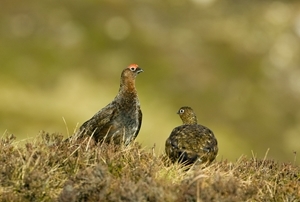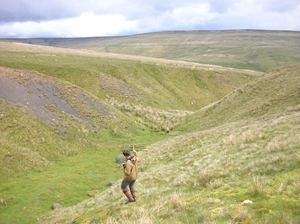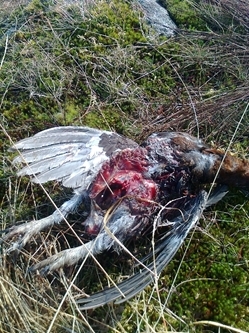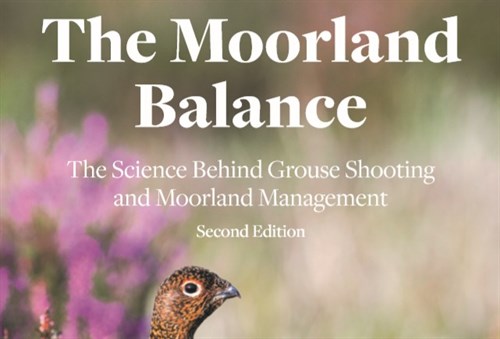Key points
- Understanding the underlying causes of population change can help focus conservation management for a species.
- Survival of both adults and chicks were the key life stages for the red grouse population at Langholm Moor, with low survival limiting population recovery during 2008-16.
- Predation, mostly associated with raptor signs, was the most important factor determining adult survival and was closely linked to low rates of chick survival.
Background
 In 2008, grouse moor management was restored on Langholm Moor with the aim of increasing red grouse numbers enough to resume driven shooting, while also maintaining the hen harrier population.
In 2008, grouse moor management was restored on Langholm Moor with the aim of increasing red grouse numbers enough to resume driven shooting, while also maintaining the hen harrier population.
Gamekeepers legally controlled predators such as red foxes and carrion crows, managed heather by burning or cutting, and medicated grouse against intestinal parasites. To reduce the impact of hen harrier predation on grouse, diversionary food was provided to all hen harrier broods.
Red grouse initially responded to the restoration of management with a moderate population increase (2008-14), but grouse numbers had declined again by 2016.
This study aimed to find out which red grouse life stages, from clutch to adult, were most important in explaining the observed population changes on Langholm Moor, and therefore were important for the limited population recovery.
What they did
 The scientists collected data on red grouse density, breeding success and survival by counting grouse before and after the breeding season and by monitoring individual radio-tagged birds. They monitored the nests of radio-tagged females to record clutch size (number of eggs laid), nesting success (proportion of nests with at least one egg hatching), hatching success (proportion of eggs hatching in successful nests), and chick survival.
The scientists collected data on red grouse density, breeding success and survival by counting grouse before and after the breeding season and by monitoring individual radio-tagged birds. They monitored the nests of radio-tagged females to record clutch size (number of eggs laid), nesting success (proportion of nests with at least one egg hatching), hatching success (proportion of eggs hatching in successful nests), and chick survival.
The scientists then analysed the data, to identify which life stages contributed most to the observed population changes.
Grouse carcasses were collected throughout the study to assess causes of death, i.e. predation (signs of raptor, signs of mammal, or unknown predator), fence or road collisions, and unknown.
What they found
 Population changes are generally determined by birth and death rates (i.e. breeding success and survival), as well as movement between populations. At Langholm such movement was likely to be minimal, because it was isolated from other grouse moors.
Population changes are generally determined by birth and death rates (i.e. breeding success and survival), as well as movement between populations. At Langholm such movement was likely to be minimal, because it was isolated from other grouse moors.
When estimates of breeding success and survival were based on grouse counts, a combination of adult survival in both summer and winter contributed most to population change. When estimates were based on radio-tagged birds, adult summer survival and chick survival contributed most to population change. The contributions of clutch size, nesting success and hatching success were insignificant.
Examination of 1,442 grouse carcasses found that 93% showed signs of predation or scavenging (82% raptor, 8% mammal, 3% unknown predator), 3% of collisions, and for 4% the cause of death was unknown.
What does this mean?
Understanding the underlying causes of population change is important to manage animal populations, both for conservation and game management.
This study found that the survival rates of red grouse adults and chicks contributed most to population change on Langholm Moor and reduced the rate of population recovery between 2008 and 2016. Several factors may influence these rates but studying grouse carcasses suggested that predation associated with raptor signs was the most important factor determining adult survival. This was closely linked, possibly alongside weather, to low rates of chick survival. However, it is possible that some grouse may have been scavenged by raptors rather than killed by them.
Read the original paper
Ludwig, S.C., Aebischer, N.J., Bubb, D., Roos, S., & Baines, D. (2018). Survival of chicks and adults explains variation in population growth in a recovering red grouse Lagopus lagopus scotica population. Wildlife Biology, 2018: wlb.00430: 1-10. doi: 10.2981/wlb.00430
About the LMDP
This study was part of the Langholm Moor Demonstration Project, a long-running collaboration between the GWCT, SNH, Buccleuch Estates, the RSPB and Natural England, which aimed to resolve the conflict between driven grouse shooting and raptor conservation. Further papers from the Langholm Moor Demonstration Project can be found on the LMDP website.
Photo credit: David Kjaer

The Moorland Balance - eBook - only £4.99
Get the science behind grouse shooting and moorland management. Building on the success of the first edition, this new and improved version condenses thousands of pages of scientific literature into easy-to-read questions and answers. Over 200 different studies from across the scientific community are referenced in this 134-page book.
View Book >
or
Buy Now - £4.99 >
100% Secure. All Credit & Debit cards, PayPal, Apple Pay and Google Pay accepted.
